MSI GT627: Bringing Balance to the Force?
by Jarred Walton on April 29, 2009 4:00 AM EST- Posted in
- Laptops
Power Requirements
Power requirements with a laptop plugged in don't necessarily reflect power requirements when a laptop is on battery power. In particular, high-end GPUs run at lower maximum clock speeds when using the battery. Keep this in mind when looking at the following numbers. We test under idle conditions, with a 100% load placed on the CPU via Folding@Home SMP, and finally at maximum load by running FAH SMP at the same time as we loop 3DMark06 (at the native LCD resolution).
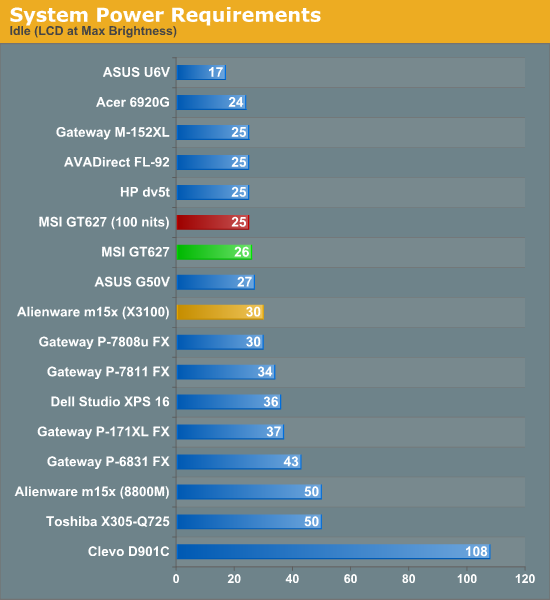
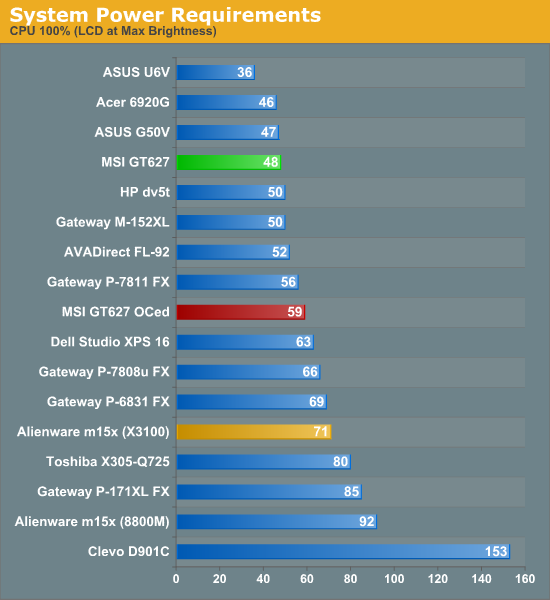
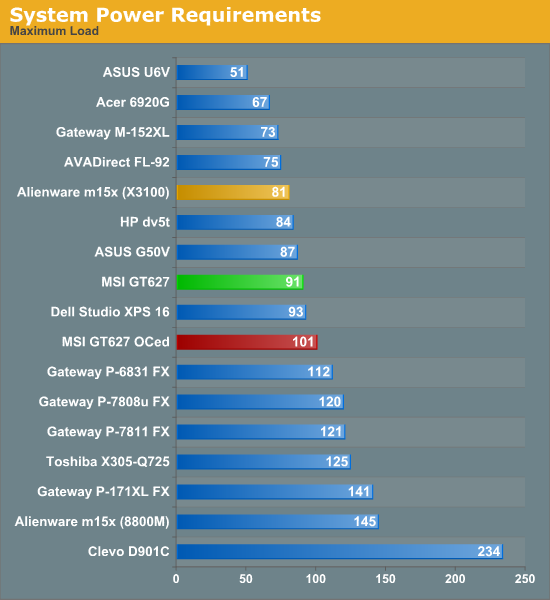
Our power measurements are with the LCD at maximum brightness, which isn't necessarily a fair way of doing things as some LCDs are much brighter than others are. Unfortunately, we don't have most of the laptops around to retest. The MSI GT627 only uses 1W more power running at maximum brightness, however, which represents an increase in power draw of just 4%. On the other hand the Dell Studio XPS 16 only uses 9W (33%) more power at maximum brightness. The other interesting thing to look at is power requirements when the CPU is overclocked. Since it's extremely simple to enable/disable overclocking (press the Turbo button), we only recommend it when you're doing something that's CPU intensive. In such situations, overclocking increases power requirements by 10-11W. You definitely wouldn't want to overclock the system when you're running on battery power!
In terms of overall power requirements, the 15.4" chassis helps MSI to provide reasonable gaming performance without using substantially more power than some non-gaming (i.e. GeForce 8600M or lower GPU) laptops. Looking at battery life and performance, the MSI GT627 would be a far better choice than laptops like the HP dv5t or Gateway M152-XL. Either buy a laptop that offers noticeably better battery life and lower performance, or jump to the MSI GT627. Graphics chips like the GeForce 8600M/9500M and Mobility Radeon 3650 just seem to use too much power and offer too little performance in return.
Noise Levels
We also ran noise testing using an SPL meter at 24" under the same conditions as our power tests.
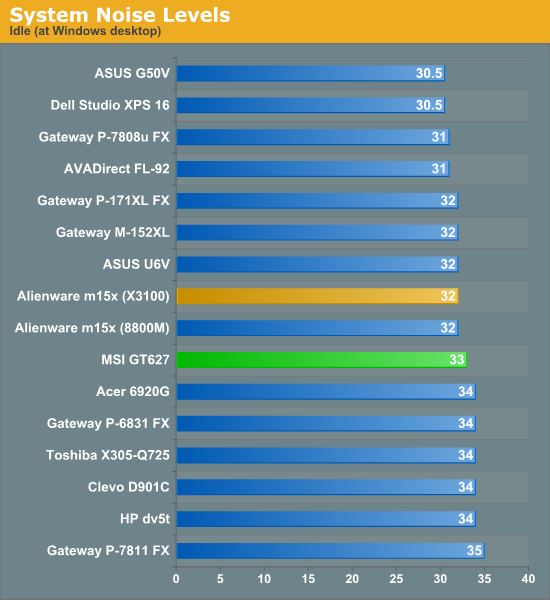
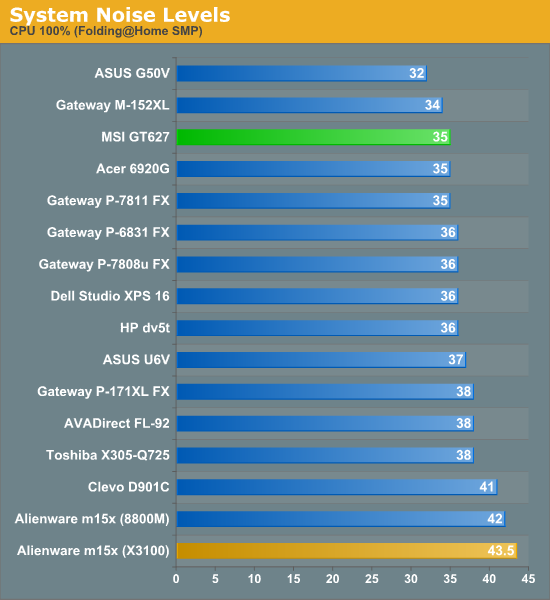
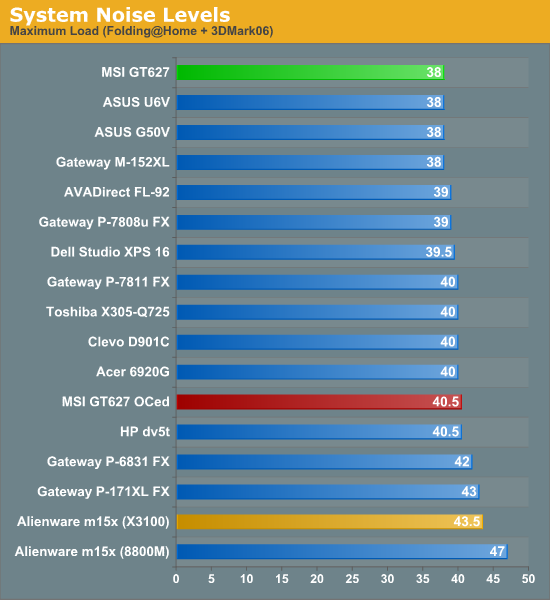
Idle noise levels aren't the best, but otherwise the GT627 does quite well in this test. Also interesting to note is that overclocking didn't affect idle noise levels, but it did add over 3dB to the CPU and maximum load results.
Temperatures
We didn't create any charts, but we wanted to give a quick rundown of the temperatures you might expect from the GT627. We placed a maximum load on the system for 60 minutes (looping 3DMark06) and then measured temperatures, so these results are something of a worst-case scenario. However, the testing environment was only 67°F, so in warmer conditions the notebook will likely run a bit warmer. Also note that the notebook was sitting on a hard, flat surface - you can use it on your lap, but if you block the ventilation slats temperatures may also increase.
We measured temperatures of up to 50°C at the exhaust, which is by far the hottest spot on the chassis. Temperatures on the bottom of the laptop range from 24° to 41°, with most of the bottom measuring around 35°C. The keyboard and palm rest aren't quite as hot, ranging from 25° to 33°C with most of the keyboard staying under 30°. Compared to the Gateway P-7808u, a few areas are slightly hotter but overall the difference is less than a couple degrees. The combination of slightly lower performing parts with a smaller 15.4" chassis works well.










47 Comments
View All Comments
fwacct4 - Saturday, May 2, 2009 - link
I'm glad noise has been evaluated in this laptop review as well. Lots of stuff on desktop noise, but since I can't stick a laptop in a closet and still run it, fan noise on a laptop distracts me like nothing else. Even worse are laptop fan noise coming from people sitting near me.Rolling Camel - Friday, May 1, 2009 - link
I'm really looking forward to a GT725, it is the uber notebook below $2000, not Gateway. My A64 3000+ is really slow and i need a computer with enough graphics power. So either i get an Phenom 2 X3 and Hd4870 based system, or get the GT725. The desktop is cheaper and more powerful, but i need mobility for my school.I know the GT725 has some worries:
1.The keyboard, although there is a solution for it.
2.Many report that the track pad wears fast, as if i will ever use.
3.I'm worried about the thermal dissipation. The R770 seems more fit for the task.
4.Warranty and customer service.
The HD4670 equipped EX 625 is very tempting with it's $750 price tag.
ira176 - Friday, May 1, 2009 - link
Apple's batteries are custom made lithium polymer. They are not typical run of the mill lithium ion cells that most manufacturers use. Apple's batteries use all of the space in their design and have no "dead" space due to round cells packed in a rectangular battery as most win pc notebooks have. Although Apple's OS may be a little more conservative on battery usage it's got to be the mere fact that there's more capacity in their battery design, and maybe even cherry picked hardware and LED lcd displays. Win pc's could probably see better battery life with better battery designs and better part choices. Of course we would pay more for that pc notebook.JarredWalton - Friday, May 1, 2009 - link
Apples batteries are rated at between 40 Whr and 50 Whr in the current models - 40 for the Air, 45 for the standard MacBook, and 50 for the Pro if I'm not mistaken. The construction and material used in a battery does not affect the rating in Whr. If something is designed to output 5200 mA at 9.6V, it is a 50 Whr battery. A lithium polymer might be lighter for the total capacity, but I'm not talking about capacity.Given the above, it means that Apple's standard MacBook apparently consumes around 9.4W when surfing the Internet. In contrast, the ASUS U6V eats up 21W on average for the same task. I'm hoping to get a MacBook for a bit just to make sure there's nothing else going on, but Apple apparently uses less power surfing than most Vista PCs use at idle.
Zan Lynx - Friday, May 1, 2009 - link
From what I've gathered about it, Apple "cheats." They can turn hardware on and off and do clock scaling that isn't available via ACPI.JarredWalton - Friday, May 1, 2009 - link
Lenovo indicated to me at CES that they actually turn off components that aren't in use, which is how they improve battery life (supposedly - still waiting for a test sample). It makes sense that if your optical drive is inactive, completely shutting off power makes more sense than a .5W sleep state. They said they also power off the speakers when the sound is muted or when headphones are connected (another few hundred mW). I don't know about other devices, but really I don't care if it's "cheating" - custom designed hardware that functions better than the competition is fine as long as it works properly. Windows 7 is supposed to enable some better power savings (up to 11% better battery life I've heard), so we'll see.The0ne - Thursday, April 30, 2009 - link
If you're going to game on it why not just get one with 17" LCD? Better yet, get one with 1900x1200 and everything is just beautiful :)It's great that the article addresses the LCD issues. I mean come on, it's one of the main components when considering a laptop.
Rob94hawk - Thursday, April 30, 2009 - link
Where is this Clevo901c laptop?JarredWalton - Thursday, April 30, 2009 - link
I'm not sure what you mean. Do you mean where are the specs? If that's your question, the Sager NP9262 is a Clevo D901C chassis. Several other companies (WidowPC, AVADirect, Eurocom, etc.) use the Clevo chassis and rebrand it as their own, so I figured listing the original manufacturer in that case made the most sense.GoatMonkey - Wednesday, April 29, 2009 - link
The display on the MSI GT627 218US is apparently different, because it is listing max resolution of 1680x1050. I'd like to know if that display has better contrast ratio.Also, any news on the upcoming MSI GT628 with the nVidia M160?